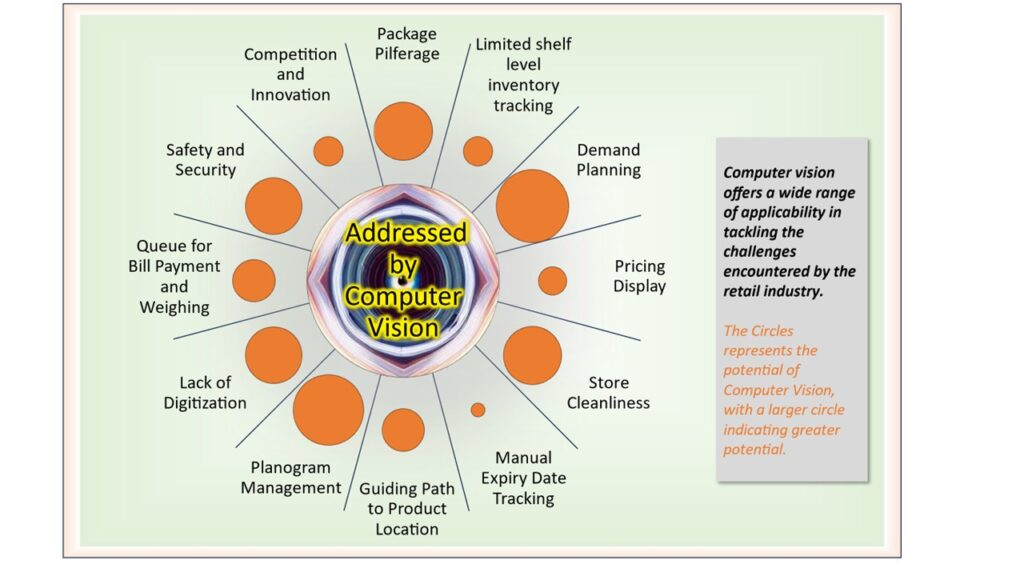

Close


Introduction to the retail landscape
The retail sector serves as a cornerstone of modern economies, seamlessly connecting producers and consumers through diverse preferences. Ranging from local shops to sprawling superstores, it reflects economic dynamics, employment trends, and cultural shifts. In the age of rapid technological advancements, supermarkets grapple with unique challenges that necessitate innovative solutions. This article delves into the distinctive hurdles faced by supermarkets within the broader retail context and explores how these challenges are driving the adoption of cutting-edge technologies, reshaping the retail experience. The provided image illustrates the significant growth and trends in the global retail industry and the retail analytics market. As the industry evolves, understanding these shifts is crucial for businesses to thrive and adapt to the changing retail landscape.

Image credits to https://www.latentview.com/infographics/retail-industry-trends-and-forecasts-for-2023-and-beyond/
Emerging Trends and Innovations in Retail
The future of the retail industry, particularly in supermarkets, is on the cusp of dynamic transformation, fueled by emerging trends and groundbreaking innovations. Supermarkets are also embracing automation and robotics to optimize inventory management and streamline order processes. Ethical and eco-friendly practices gain prominence, resonating with sustainability-conscious consumers. AI-powered decision-making shapes consumer behavior, while instant deliveries, transparent supply chains, and fortified data security are becoming industry benchmarks. Social commerce and hyper-personalization are poised to empower supermarkets to swiftly adapt to ever-evolving consumer preferences. As these transformative trends gain momentum, retailers stand at the vanguard of reshaping the landscape, poised to deliver tailored, efficient, and responsive shopping experiences, ushering in a new era of customer-centric retailing that redefines the entire shopping journey. The convergence of these strategies will undoubtedly set the stage for a retail revolution.
The convergence of these strategies will undoubtedly set the stage for a retail revolution
Transforming Retail Supermarkets: Innovative Solutions for Dynamic Challenges
In the dynamic landscape of supermarkets, challenges catalyze innovation, reflecting evolving consumer behaviors, market dynamics, and technological progress. These multifaceted hurdles include package pilferage, posing a threat to product security; limited inventory tracking, resulting in stockouts and customer dissatisfaction; pricing display inconsistencies, eroding transparency; store cleanliness impacting customer perception; and manual expiry date tracking causing potential product wastage. As portrayed in the image below, these challenges illustrate the intricate terrain that retail supermarkets navigate daily, underscoring the imperative for transformative solutions to ensure seamless operations and deliver enhanced customer experiences and satisfaction.

Amidst these challenges, the retail supermarket industry is poised for transformation. In this pursuit, supermarkets seek inventive ways to stay competitive and responsive. This is precisely where computer vision emerges as a crucial ally. Through AI and visual recognition, computer vision offers tailored solutions that can redefine inventory management, enhance customer interactions, and streamline supermarket operations.
Understanding Computer Vision Solutions: At the heart of this transformative journey lie cutting-edge computer vision solutions. These encompass a spectrum of AI-powered tools, including smart inventory monitoring, real-time analytics, customer behavior analysis, and interactive shopping experiences. By harnessing sophisticated algorithms, these solutions decode intricate visual data, yielding actionable insights that optimize efficiency and personalize the entire retail journey. The ensuing table artfully delineates prevalent pain points within the retail sphere, aligned with corresponding computer vision solutions that collectively herald a more streamlined, dynamic, and customer-centric future.
| Problems | Description | CV solution |
|---|---|---|
| Package pilferage | Stock theft of high-value items, causing significant losses | Immediate alerts for intervention Real-time video analysis to detect theft. |
| Limited inventory tracking | Absence of real-time tracking leads to inefficient inventory management | Smart Inventory Management Solution Automated monitoring of stock levels. |
| Wastage & stock availability | Inefficient demand planning results in wastage or shortages of perishable items. | Demand Forecasting Solution Enhance demand forecasting by sales analyzing sales data & customer behavior patterns. |
| Safety & Security | Ensuring the safety of customers, employees, and products is a challenge. | Hazard detection. Real-time video analysis for detecting suspicious activities. |
| Planogram management | Poor planning leads to disorganized shelves and missed cross-selling opportunities. | Planogram Management Solution Real-time monitoring of product placement. |
| Store cleanliness | Difficulty in maintaining cleanliness due to customer behavior and high foot traffic. | Immediate alerts for cleaning Real-time monitoring of store cleanliness. |
Conclusion
In conclusion, the retail industry is undergoing a transformative journey, adapting to evolving consumer behaviors and technological advances. Supermarkets, as a vital part of this landscape, face unique challenges that necessitate innovative solutions. Businesses can explore diverse strategies, including point solutions, DIY integration, or embracing comprehensive options like SquirrelVision. These encompass a wide range of capabilities, empowering businesses to usher in a future of efficient, customer-centric retail, empowered by cutting-edge technologies such as computer vision. As the industry evolves, supermarkets are at the forefront of reshaping the retail experience, poised to deliver tailored, efficient, and responsive shopping journeys that cater to the ever-changing needs of consumers.